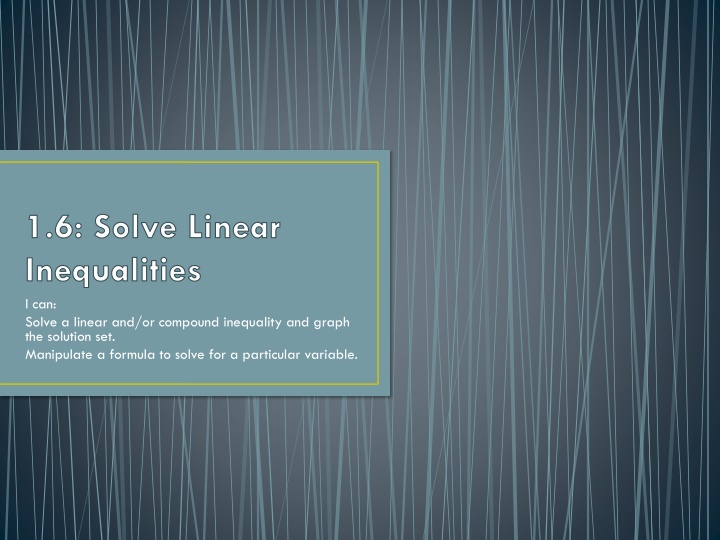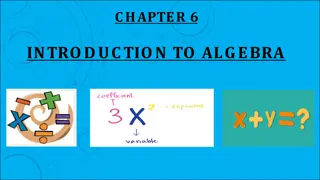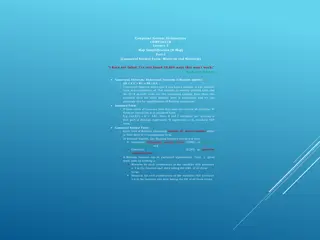
Linear Inequalities: Graphing Solutions and Manipulating Formulas
Explore linear inequalities, compound inequalities, and manipulating formulas to solve for variables. Learn how to graph solutions, solve real-world problems, and answer questions about grades, budgeting, and more using linear inequalities.
Download Presentation

Please find below an Image/Link to download the presentation.
The content on the website is provided AS IS for your information and personal use only. It may not be sold, licensed, or shared on other websites without obtaining consent from the author. If you encounter any issues during the download, it is possible that the publisher has removed the file from their server.
You are allowed to download the files provided on this website for personal or commercial use, subject to the condition that they are used lawfully. All files are the property of their respective owners.
The content on the website is provided AS IS for your information and personal use only. It may not be sold, licensed, or shared on other websites without obtaining consent from the author.
E N D
Presentation Transcript
1.6: Solve Linear Inequalities I can: Solve a linear and/or compound inequality and graph the solution set. Manipulate a formula to solve for a particular variable.
Key Vocabulary Linear Inequality Compound Inequality Equivalent Inequalities
Linear Inequality Can be written in one of the following forms where a and b are real numbers and a does not equal 0.
Compound Inequality Consists of two simple inequalities joined by and or or
GUIDED PRACTICE for Examples 1 and 2 Graph the inequality. 1. x > 5 The solutions are all real numbers greater than 5. An open dot is used in the graph to indicate 5is not a solution.
GUIDED PRACTICE for Examples 1 and 2 Graph the inequality. 2. x 3 The solutions are all real numbers less than or equal to 3. A closed dot is used in the graph to indicate 2is a solution.
GUIDED PRACTICE for Examples 1 and 2 Graph the inequality. 3. 3 x < 1 The solutions are all real numbers that are greater than or equalt to 3 and less than 1.
GUIDED PRACTICE for Examples 1 and 2 Graph the inequality. 4. x < 1 orx 2 The solutions are all real numbers that are less than 1 or greater than or equal to 2.
Why? Near the end of the semester or school year, I have students ask me what scores they must get on a final in order to earn a particular grade. You can use linear inequalities to answer this question. You budgeted x amount of dollars for movies. You have already spend $50 of the amount. You can use inequalities to determine staying under budget or reaching your budgeted target.
GUIDED PRACTICE for Examples 3 and 4 Solve the inequality. Then graph the solution. 5. 4x + 9 < 25 4x + 9 < 25 Write original inequality. Subtract 9from each side. 4x < 16 x < 4 Divide each side by 4. 6. 1 3x 14 1 3x 14 Write original inequality. 3x 15 Subtract 1from each side. x 5
GUIDED PRACTICE for Examples 3 and 4 Solve the inequality. Then graph the solution. 7. 5x 7 6x 5x 7 6x Write original inequality. Subtract 5xfrom each side. x > 7 8. 3 x > x 9 3 x > x 9 3 2x > 9 2x > 12 x <6 Write original inequality. Subtract xfrom each side. Subtract 3from each side. Divide each side by 2 and reverse.
EXAMPLE 6 Solve an or compound inequality Solve 3x + 5 11 or 5x 7 23 . Then graph the solution. SOLUTION A solution of this compound inequality is a solution of either of its parts. First Inequality 3x + 5 113x 6x 2 Second Inequality 5x 7 235x 30x 6 Divide each side by 5. Write first inequality. Write second inequality. Add 7 to each side. Subtract 5 from each side. Divide each side by 3.
GUIDED PRACTICE for Examples 5,6, and 7 Solve the inequality. Then graph the solution. 9. 1 < 2x + 7 < 19 1 < 2x + 7 < 19 1 7 < 2x + 7 7 < 19 7 8 < 2x < 12 Write original inequality. Subtract 7 from each expression. Simplify. 4 < x < 6 Divide each expression by 2. ANSWER The solutions are all real numbers greater than 4 and less than 6.
GUIDED PRACTICE for Examples 5,6 and 7 Solve the inequality. Then graph the solution. 10. 8 x 5 6 8 x 5 Write original inequality. 6 8+5 x 5 + 5 6 + 5 Add 5 to each expression. 3 x 11 11 x Simplify. 3 ANSWER The solutions are all real numbers greater than and equal to 11 and less than and equal to 3.
GUIDED PRACTICE for Examples 5,6 and 7 Solve the inequality. Then graph the solution. 11. x + 4 9 orx 3 7 SOLUTION A solution of this compound inequality is a solution of either of its parts. First Inequality x + 4 9 Second Inequality x 3 7 Write first inequality. Write second inequality. Add 3 to each side. x 10 x 5 Subtract 4 from each side.
GUIDED PRACTICE for Examples 5,6 and 7 ANSWER The graph is shown below. The solutions are all real numbers. less than or equal to 5 or greater than or equal to 10.
GUIDED PRACTICE for Examples 5,6 and 7 Solve the inequality. Then graph the solution. 12. 3x 1 < 1 or 2x + 5 11 SOLUTION A solution of this compound inequality is a solution of either of its parts. First Inequality 3x 1< 1 Second Inequality 2x + 5 112x 6 x 3 Divide each side by 5. Write first inequality. Write second inequality. Subtract 5 from each side 3x 0x 0 Add 1 each side . Divide each side by 3.
GUIDED PRACTICE for Examples 5,6 and 7 ANSWER The graph is shown below. The solutions are all real numbers. less than 0 or greater than or equal to 3.






















